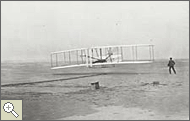
Among the many letters the Smithsonian received on June 2, 1899, was a request for information on human flight. The writer, Wilbur Wright of Dayton, Ohio, wished to obtain “such papers as the Smithsonian Institution has published on this subject, and if possible a list of other works in print in the English language.” Wilbur Wright was unknown to the Smithsonian. He and his younger brother, Orville, were co-owners of a small shop that sold hand-built bicycles. His letter affirmed his obscurity—he saw fit to mention that he was not a “crank.”
“I am an enthusiast, but not a crank in the sense that I have some pet theories as to the proper construction of a flying machine,” he wrote. “I wish to avail myself of all that is already known and then if possible add my mite [little bit] to help on the future worker who will attain final success.”
Wilbur and Orville, thirty-two and twenty-eight years old in 1899, lived together in the Wright family house, along with their sister, Katharine, and their father, Milton, a bishop of an evangelical church. The brothers became interested in flight as children, when their father brought home a little flying toy powered by a rubber band. Their interest was renewed in 1896, when they read about a famous German experimenter named Otto Lilienthal and his fatal crash in what we would now call a hang glider. The Wrights did not have “pet theories” about flying, but they quickly identified the crucial problem of aviation at the time—the lack of a means of maintaining balance and control.
A Smithsonian official responded to Wilbur’s letter by sending several pamphlets and a list of books. In a note, he mentioned that a book by Smithsonian Secretary Samuel P. Langley, Experiments in Aerodynamics, was available for one dollar. Wilbur promptly sent a note of thanks and a dollar for the Langley work.
Thus ended what Wright brothers biographer Tom Crouch has called “the most important exchange of correspondence in the history of the Smithsonian.” A little more than a year after the Wrights began studying the pamphlets, they were well on their way to solving the problems of balance and control. In less than five years, they solved every problem that had prevented humanity from taking wing. On December 17, 1903, Orville Wright flew in a motor-powered craft for twelve seconds across 120 feet of sand near Kitty Hawk, North Carolina. It was, as Orville put it, “the first time in the history of the world that a machine carrying a man and driven by a motor had lifted itself from the ground in free flight.”
|
 |
 |
 |
 |

The First Flight
|
 |
 |

The first flight, December 17, 1903, at the moment of takeoff
|
 |
 |
 |
|

